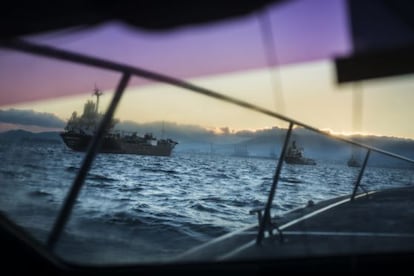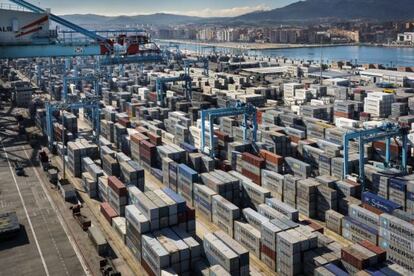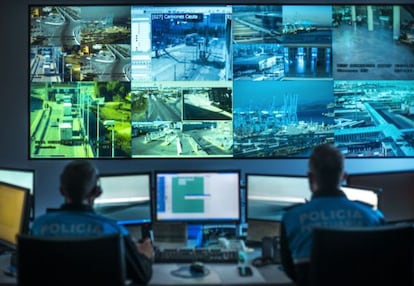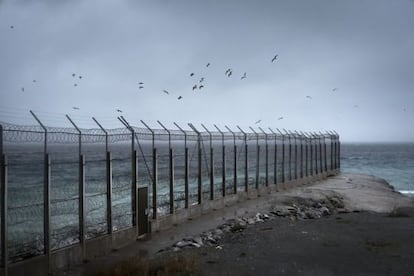Safeguarding the Strait of Gibraltar
The stretch of water that separates Spain and Morocco is a major global hotspot

One of the planet’s major hotspots, the Strait of Gibraltar is among Spain’s biggest security headaches. Aside from the British and US military bases there, it is a crossroads for a range of illegal activities, notably drugs, arms, and people trafficking, all of which are increasingly connected with the growing threat from radical Islam. Morocco, across the water, is the world’s second-largest producer of hashish after Afghanistan, and most of it enters Europe via Spain, in fishing boats, speedboats, light aircraft, or containers, only five percent of which are checked when they enter Algeciras port. In 2013, around 300 tons of hashish was seized in Spain, 90 percent of it in Andalusia. “Of course the jihadists finance their activities with hashish smuggling, just like the Taliban fund themselves with heroin, and Latin American guerrillas through cocaine,” says a senior Civil Guard officer.
After the English Channel, the Strait is the world’s busiest shipping lane: around 110,000 vessels traveling between south-east Asia, China and the Middle East and the Atlantic coastline of Europe, Africa, and the United States, passed through it 2014, while around half of the world’s trade, a third of its oil and gas, and 80 percent of the goods and gas consumed by the EU, all move through this 100-kilometer maritime corridor. Around half the gas required by Spain, and a large part of its oil, arrives at the country’s refineries via the Strait of Gibraltar. The largest, Cepsa’s San Roque refinery, is located in the Bay of Algeciras.
In the decade following 9/11, the US put the Strait at the center of NATO operations to counter the threat of jihadist groups
Aboard a Spanish Navy vessel heading westwards, you can make out the Pillars of Hercules, the entrance to the Mediterranean, from 40 nautical miles away – Morocco’s Mount Musa on the port side, and Gibraltar to starboard. As you approach the Atlantic, the Strait gradually narrows to just eight miles across, a swirling torrent that separates Africa from Europe, and notorious for its treacherous currents and sudden storms.
In addition to the tankers and container vessels from all over the world, there is also a huge military presence in the Strait: as well as the US and British vessels visiting Gibraltar and Rota, the bulk of the Spanish fleet is stationed here. Above, the skies are patrolled by Spanish and US aircraft operating out of the Morón air base, two hours inland in Seville province, while the Royal Navy and US fleet have installed sophisticated monitoring equipment throughout the area, as has Spain. There is also an artillery operations center near Tarifa that is able to detect naval targets up to 20 kilometers away, and Patriot missiles stationed in San Roque that can identify threats at up to 150 kilometers. Across the waters, Morocco has its own naval base at Ksar es Seghir, where its European-made warships are stationed. It’s as though the Cold War never ended.
In the decade following 9/11, the United States put the Strait at the center of NATO operations to counter the threat of jihadist groups, which have used the countries bordering the Sahara as a base, and are now increasingly focused on Algeria and Libya: the first is among the EU’s main suppliers of gas, while the second is a state in freefall. To further complicate matters, the US military convoys headed for operations in Africa, Asia, and the Middle East also pass through the Strait. The Pentagon now has Spain’s permission to station up to 3,000 marines at Morón, from where they can be flown to anywhere in Africa where Washington feels its interests are threatened by radical Islam.

Félix Arteaga, who coordinated a recent report by the Elcano Royal Institute think tank called España mirando al Sur: del Mediterraneo al Sahel (or, Spain looks south: from the Mediterranean to the Sahel), sees three worrying scenarios for Spain from North Africa: “The destabilization of Algeria and Morocco if their governments lose part of their territory to the terrorists; the sustainability of Ceuta and Melilla; and failure to take advantage of the economic opportunities available to us in Africa. We need to understand that the better things are for our neighbors, the better things are in North Africa, the better things will be for us. If the Moroccan monarchy falls or [President Abdelaziz] Bouteflika is overthrown in Algeria, the resulting problems will affect us more than any other country in Europe. The tragedy of Africa is that its young people have absolutely no hopes for the future. The European Union has to help Africa, if only to protect itself.”
Ships in the Strait pass along two channels just 2.5 nautical miles wide in either direction. They are separated by a half-mile strip that can only be crossed by the ferries that travel between Tangier and Algeciras 35,000 times a year.
The Mediterranean’s two busiest ports are here. Algeciras, which has become a strategic point in the transport of goods between East and West, handled around five million containers in 2014. Across the Strait in Morocco, three million more went through Tanger Med I, which opened in 2007. Once the second phase of what is already the biggest port in North Africa is complete, it will be able to handle a total of eight million containers a year.
Between them, the two ports are looking at handling more than 13 million containers a year. Any serious event that interferes with the passage of ships – a catastrophe, terrorist attack, spill, or accident involving a ferry or oil tanker – would bring traffic to a halt, setting off a chain reaction that would endanger energy supplies, send oil and maritime insurance prices up, and rock the world economy. In short, a global crisis.
For as far as the eye can see, ships fill the Bay of Algeciras. Around 300 large vessels – not including leisure craft – pass through these waters each day, along with those that anchor here to refuel via bunkering services based in Gibraltar. The Spanish authorities have complained to the EU about the environmental risk posed by this business, which involves around seven million tons of fuel a year.
But the fact of the matter is that moving containers by sea is still the cheapest option for exporters. While a train can haul up to 100 containers, the Triple E vessels run by Danish company Maersk that frequently pass through Algeciras carry more than 18,000 and take just 20 days to get here from China. It's a spectacular sight to watch them being unloaded during the middle of the night under spotlights, with a single stevedore managing the operation from a crane 70 meters above. The containers are loaded on to smaller vessels and 10 days later arrive in the United States – or less than a week in Rotterdam, Hamburg or the Baltic. By using the Strait, container vessels are able to meet strict timetables, as Rocío García of the Algeciras port authority explains: “Just losing one day of sailing means losing a lot of money and Algeciras is an essential part of global maritime trade: it is in the center of the world, there is no alternative other than going round Africa.”

The Spanish government assumes that the Strait of Gibraltar is a prime target for jihadist groups. In October 2000, Al Qaeda claimed responsibility for a suicide attack using a motor launch filled with explosives that rammed into the USS Cole in the Gulf of Aden, another of the world’s busiest shipping routes, killing 17 marines. In 2002, French tanker the MV Limburg was attacked in Yemeni waters, provoking extensive environmental and economic damage. The same year, Moroccan authorities dismantled an extremist cell that was preparing to attack British and US warships patrolling the Strait. The most recent jihadist threat to emerge came at the end of 2014, when Resurgence, Al Qaeda’s propaganda publication, urged its followers to intensify attacks on the planet’s main choke points with the goal of destabilizing the global economy. Among the objectives Al Qaeda mentioned was the Strait of Gibraltar.
Aboard the Vigía, a Spanish navy vessel covering the waters between Cabo de Gata in Almería and the Bay of Cádiz, Captain Luis Medina explains that his mission is to “patrol, dissuade, defend our interests, and maintain a continuous presence in these waters.” The Vigía has a crew of 46, seven of whom are women, along with a unit of marines whose job is to board suspicious vessels. The ship is constantly on patrol, and its crew is relieved every two weeks. Part of NATO’s Operation Active Endeavour, set up to protect military and trading vessels in the Strait after 9/11, its officers regularly question ships in the area regarding their registration details, the port they have left, their destination, what time they are due to arrive there, who owns the vessels, what they are carrying, and if it is dangerous. Non-military vessels over 300 tons are obliged to use their Automatic Identification System, which provides information on their location and other data.
While a train can haul up to 100 containers, the Maersk Triple E vessels that frequently pass through Algeciras carry more than 18,000
When the Vigía’s radar locates a vessel that has disconnected its AIS in the Strait, it goes after it. The same applies to ships that are at anchor, zigzagging, or sailing close to shore. “We could be dealing with anything from drug traffickers, smugglers, illegal fishing, treasure hunters or vessels tipping waste illegally. Our job is to stop it,” says Captain Medina.
The Vigía is not a warship; it’s a maritime action vessel, a new security concept far removed from the traditional idea of the navy as a combat force, and more in line with that of it as a defender of Spain’s immediate interests: from supporting the fishing fleet, fighting against trafficking, protecting the environment, helping in maritime rescue missions, as well as knowing what every ship in Spanish waters is up to. According to Admiral Fernando García Sánchez, head of the Joint Chiefs of Staff, this new concept of maritime security aims to “achieve the best levels of anticipation, prevention, efficiency, sustainability of resources, and resistance and recovery capability at sea. We try to contribute to the opportunities provided by the licit uses of the sea to Spain’s benefit, while preventing their use for criminal activities.”
The information acquired by the Vigía during its voyages is transmitted in real time to COVAM, the Maritime Action Surveillance Operations Center, based in the Mediterranean port city of Cartagena. The center monitors all activity not just in the Strait of Gibraltar, but anywhere Spanish naval vessels are active, for instance, protecting fishing boats in the Gulf of Guinea or combating piracy in the Indian Ocean. All information is at the disposal of other agencies with responsibility for Spanish waters.
Around 600 kilometers north of Gibraltar, the Civil Guard’s National Center for the Coordination of Maritime Surveillance of Coasts and Borders, located in a huge bunker in Madrid, receives information 24 hours a day. This is the Interior Ministry’s eyes and ears on the Strait of Gibraltar. On the huge screen that dominates the room each meter of the border fences around Spain’s North African enclaves in Ceuta and Melilla can be seen, along with the rest of Morocco’s Mediterranean coastline, and every palm tree all the way from France to Portugal. It also monitors each patrol area, whether on land, sea, or air, along with the Civil Guard’s own vessels off the west coast of Africa.

That information can also be crosschecked in real time with data supplied by the EU’s Frontex border agency, along with Eurosur’s drones, reconnaissance aircraft and satellites. The next stage of collaboration and integration in Spanish waters will be the Perseus Program, a piece of software able to detect ships behaving suspiciously, automatically providing full data on them within seconds and then acting within minutes.
But the Civil Guard’s main source of information for monitoring its southern coast is SIVE, the Integrated Exterior Surveillance System, a network of hundreds of cameras and radars that over the last decade has done much to cut back illegal immigration from Morocco into Spain: last year around 7,000 people made it across the Strait into Spanish waters, compared to the more than 200,000 migrants who crossed from Libya into Italy in 2014.
“The main difference between us and Italy is that Morocco cooperates fully to help prevent people trafficking, while Libya is a failed state. Italy is obliged to help all these people on its own,” says a senior Civil Guard officer. “Spain has shown that the best way to fight irregular migration is by cooperating with all the countries concerned,” he adds.
In a bid to tackle the problem of irregular migration and to improve coordination between the navy, Civil Guard, customs, and Maritime Safety, in late 2013, Spanish Prime Minister Mariano Rajoy set up the National Maritime Security Council, which meets every month.
Admiral García Sánchez says that over the last year, the council has “worked out different action plans and cooperation agreements, and employed a concerted action that means using the resources of the state and the private sector efficiently, with a focus that leads to unity of action under the authority of the prime minister.”
The Strait has so many different problems and opportunities packed into such a small space. There is nowhere else like it on the planet” A Spanish diplomat
A member of the council explains in more detail: “We have several working groups related to maritime security, from risk analysis to cyber attacks in the maritime environment and operative coordination, but the most important team is the one that works on the Strait, because that is where all the possible risks are focused and from where experience and doctrine that can be used in other areas emerges. This territory is our model for any crisis that could occur at sea; out of it has come the Integral Plan for Maritime Security in the Strait, which foresees any contingency or catastrophe that could take place on our southern frontier.”
For one Spanish diplomat, “the peculiarity of the Strait is that there are so many different problems, threats, and opportunities packed into such a small space. There is nowhere else like it on the planet.” To begin with, it’s not really one frontier – it’s four: the EU’s; Spain’s with Morocco at Algeciras; Gibraltar’s with Spain at La Linea; and Ceuta’s with Morocco. Over the centuries, this has created unique economies, ways of life, and cities that face off against each other across the border. They all seem to have made the best of it, although diplomatic relations can be difficult at times.
Take Gibraltar, a prosperous British colony of fewer than 30,000 people that costs the United Kingdom nothing, and takes military advantage of its strategic position. Gibraltar has developed a financial industry based on low taxes and banking secrecy that has attracted the online betting industry, which employs 2,000 people, as well as insurance (around 20 percent of British cars are insured via companies based here). At the same time, it provides employment for 10,000 Spaniards from Algeciras, La Línea de la Concepción, San Roque, Los Barrios, Castellar de la Frontera, Jimena de la Frontera and Tarifa – the towns that make up the Campo de Gibraltar. La Linea de la Concepción, the community closest to Gibraltar, is the distribution point for 120 million packets of cigarettes smuggled out of the Rock each year that Spain says deprives it of an estimated annual €500 million in tax.

Or take Ceuta: Morocco doesn’t recognize Spain’s sovereignty over the city, or the waters off it – as Madrid doesn’t recognize Gibraltar’s – calling it an “occupied city.” From time to time it makes a formal claim, while also accepting that the enclave provides work for at least 40,000 men and women who transport goods from it into Morocco worth around €500 million a year. In return, Morocco keeps tight control over Ceuta’s mosques – half of the city’s population of 85,000 are Muslims – via a network of imams that cannot preach without Rabat’s approval. It also prevents the hundreds of young African men desperate to make their way into Europe from organizing mass assaults on the fence put up by Spain around the city. Morocco also oversees the relationship between Algeciras and Tangier, which are competitors, but nevertheless stronger together, and able to monopolize global container traffic in this part of the world through the same company, APM, as operator. Its future is possibly about cooperation and integration.
This journey comes to an end on the ferry that links Tangier with Algeciras. It’s filled with containers. The crossing takes an hour. It’s a sunny day. There are no tourists aboard, just truck drivers. Behind us, the Moroccan coastline recedes into the distance; before us, the rocky outline of Spain rises up. With a little imagination, it is possible to see both shores as part of the same coast, framing a unique corner of the planet: a Strait growing ever more narrow.
Tu suscripción se está usando en otro dispositivo
¿Quieres añadir otro usuario a tu suscripción?
Si continúas leyendo en este dispositivo, no se podrá leer en el otro.
FlechaTu suscripción se está usando en otro dispositivo y solo puedes acceder a EL PAÍS desde un dispositivo a la vez.
Si quieres compartir tu cuenta, cambia tu suscripción a la modalidad Premium, así podrás añadir otro usuario. Cada uno accederá con su propia cuenta de email, lo que os permitirá personalizar vuestra experiencia en EL PAÍS.
¿Tienes una suscripción de empresa? Accede aquí para contratar más cuentas.
En el caso de no saber quién está usando tu cuenta, te recomendamos cambiar tu contraseña aquí.
Si decides continuar compartiendo tu cuenta, este mensaje se mostrará en tu dispositivo y en el de la otra persona que está usando tu cuenta de forma indefinida, afectando a tu experiencia de lectura. Puedes consultar aquí los términos y condiciones de la suscripción digital.
Archived In
Últimas noticias
Most viewed
- David King, chemist: ‘There are scientists studying how to cool the planet; nobody should stop these experiments from happening’
- Mexico completes its trade shift with the entry into force of tariffs on China and countries without trade agreements
- Reinhard Genzel, Nobel laureate in physics: ‘One-minute videos will never give you the truth’
- Oona Chaplin: ‘I told James Cameron that I was living in a treehouse and starting a permaculture project with a friend’
- Sinaloa Cartel war is taking its toll on Los Chapitos









































